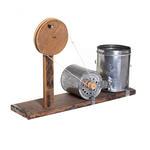Prisoner of War 'Blower'
Production date
1990s
Audio tour
See full details
Details
Description
This replica, made circa 1990, is based on a handmade heater created by prisoners of war in Italy during WW2. The original was constructed in Camp PG 35, located at the settlement of Sforzacosta, 12 miles south of Macerata in the eastern Marche region of Italy. Established as a prisoner of war camp in July 1942, by 1943 the number of inmates reached 7,250, the vast majority being British.
The handmade heaters created by prisoners of war were constructed from tin cans received in Red Cross food parcels and were joined (or crimped) together with improvised tools. The heater or blower as it was often called consisted of a fire box, an air tunnel, a crank and a small rotary fan, all made from tin. Combustible materials such as wood shavings were lit and then placed inside the fire box which would have been insulated with mud or clay. A crank would be turned to operate the small fan and blow air through the tunnel to the firebox. This is the same method used in a blacksmith’s forge.
The heaters were able to generate high enough temperatures to heat water and food received in Red Cross food parcels. The heating technique was so effective that the remaining embers from the fire box could be poured into a different heater and used to start the process again.
This is just one example of the ingenuity and resourcefulness of prisoners of war. By collecting the materials and constructing this simple but highly effective device, prisoners living in harsh conditions thousands of miles away could bring some home comforts to their new surroundings and raise morale through a hot cup of British tea.
Audio recording by Zach Ploszay (Volunteer), Manchester.
The handmade heaters created by prisoners of war were constructed from tin cans received in Red Cross food parcels and were joined (or crimped) together with improvised tools. The heater or blower as it was often called consisted of a fire box, an air tunnel, a crank and a small rotary fan, all made from tin. Combustible materials such as wood shavings were lit and then placed inside the fire box which would have been insulated with mud or clay. A crank would be turned to operate the small fan and blow air through the tunnel to the firebox. This is the same method used in a blacksmith’s forge.
The heaters were able to generate high enough temperatures to heat water and food received in Red Cross food parcels. The heating technique was so effective that the remaining embers from the fire box could be poured into a different heater and used to start the process again.
This is just one example of the ingenuity and resourcefulness of prisoners of war. By collecting the materials and constructing this simple but highly effective device, prisoners living in harsh conditions thousands of miles away could bring some home comforts to their new surroundings and raise morale through a hot cup of British tea.
Audio recording by Zach Ploszay (Volunteer), Manchester.
Collection Type
Objects
Catalogue Number
1539/1
Subject auto tags
Object Types
Part of 1 highlight set
Share
All images are the property of the British Red Cross Museum and Archives (unless otherwise indicated), and cannot be used without permission. For queries about permission to use images, please contact enquiry@redcross.org.uk.


-1%20(002).jpg)